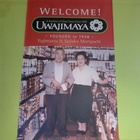According to "A Hundred Years of Japanese Americans in the United States" (Shin Nichibei Shimbunsha, 1961), after the war, the Issei returned to Seattle and competed to buy hotels, apartments, and office buildings, developing businesses in ways other than the traditional leases. Various trades and businesses run by Japanese Americans were also revived.
The following is a list of Japanese businesses in the city by type as of the end of 1948.
5 organizations, 16 churches, 19 clinics, dentists, opticians, and treatment centers, 30 offices and newspapers, 9 traders, 5 food wholesalers, 8 shops, 10 furniture, equipment, and hardware stores, 10 soy sauce manufacturers, tofu stores, and fish stores, 22 food stores, 11 pharmacies and agricultural supply stores, 9 watch stores and photo studios, 12 flower, confectionery, and fishing tackle stores, 10 shipping stores, 28 dyeing and laundry facilities, 3 liquor stores, 4 Japanese and Chinese restaurants, 21 Western restaurants, 90 hotels
(From "The Centennial History")
In January 1946, the Japanese Hotel and Apartment Association was organized, and in January 1949, the Seattle Japanese Association was founded, with 700 members and a Japanese language school as an affiliated organization. In addition, religious activities for Japanese Americans began again, such as the Seattle Japanese Church Alliance.
I've been crying for two weeks
In the above example, Uwajimaya would be one of the 22 grocery stores. Fujimatsu and Sadako are the main focus, and the eldest son Kenzo and the second son Tomio also helped out at the store from the age of 10, shortly after the war. The other children were Tomio, the third son Akira, who is three years younger than them, the second daughter Hisako, the fourth son Toshi, and the third daughter Tomoko, and of these six, the eldest daughter Suwako returned from Japan. This completes the nine-member family.
Before the war began, in February 1941, at the age of six, Suwako was placed in the care of her aunt in Fujimatsu's hometown, a small seaside village in the southwest of Ehime Prefecture. This was because Fujimatsu wanted his eldest daughter to receive an education in Japan, but he was probably also thinking about returning to Japan in the future.
Living alone and away from her parents and siblings during her impressionable age of 6 to 13 was difficult for Suwako, and she also had a hard time adjusting to her new life in America.
After arriving at her aunt's house in Ehime with her mother, she left while Suwako was sleeping. Suwako cried for two weeks after the incident, so her aunt had to stay with her. She also heard someone say that she was brought to Japan because she was naughty, which left a deep impression on her.
At home, she babysat babies and washed diapers. Also, because there were no men to help out during the war, she went to the mountains to gather potatoes and harvest wheat, working hard even as a child.
I could speak and listen to Japanese because I spoke it with my parents in Tacoma, but I couldn't write it at first. I was a child, so I had a lot of fun. Then the war started, I had no time to study, and my textbooks were burned.
As the war intensified, bombs fell on a nearby island, and while all the children were standing in the schoolyard, we saw a B-29 fly over the sky. I remember being in an air raid shelter and hearing a sound like the entrance door slamming down. I also had a scary experience that I didn't want to talk about.
Learning English with elementary school students
Just before the spring of 1948, three years after the end of the war, Suwako returned to the United States by ship with her mother's cousin. She came to Seattle, not Tacoma, where she had lived before, but the seven-year gap was so long that when she was reunited with her parents and siblings, they were unfamiliar to her.
"It was hard. I wanted to go back to Japan. I didn't understand English. I had a hard time in Japan and then in America..." Suwako thought.
However, what saved me was the elementary school students who were seven years younger than me. I hadn't studied English when I lived in Tacoma, so I enrolled in the first grade of elementary school in Seattle and studied English, but thanks to my small classmates, I was able to improve my English. Also, my teacher was very kind and told me not to forget Japanese. I started studying again in elementary school and eventually skipped a grade and went on to junior high school.
In Seattle, she helped her mother with the housework. She prepared meals, ironed the food, and did all the other housework while her parents were busy working. At the time, the house was lively, not only with her family, but also with someone her parents would have invited. Her parents loved to entertain people, so they never had dinner at the table alone.
(Titles omitted)
© 2018 Ryusuke Kawai







